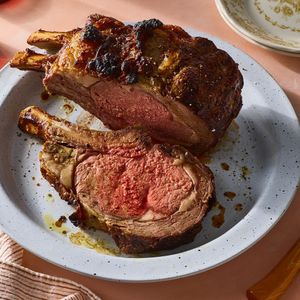Ingredients
Equipment
Method
- Remove the rib roast from the refrigerator at least 2-3 hours before cooking to allow it to come to room temperature.
- Pat the roast dry with paper towels. Score the fat cap in a crosshatch pattern, being careful not to cut into the meat.
- Generously rub the roast all over with flour, then season heavily with salt and freshly ground black pepper.
- Place the seasoned roast, fat-side up, on a rack in a sturdy roasting pan.
- Preheat your oven to 450°F (230°C).
- Roast the beef for 15-20 minutes at 450°F (230°C) to sear the exterior.
- Reduce the oven temperature to 325°F (160°C) and continue roasting.
- Insert an instant-read meat thermometer into the thickest part of the roast, avoiding bone. Cook until the internal temperature reaches your desired doneness (e.g., 125°F for rare, 130-135°F for medium-rare, 140-145°F for medium).
- Remove the roast from the oven, transfer it to a carving board, and tent loosely with foil. Let it rest for at least 20-30 minutes before carving. The internal temperature will rise 5-10 degrees during this time.
- Slice the roast against the grain and serve immediately. If desired, use pan drippings to make a simple pan gravy by deglazing with beef stock or broth.
Notes
For a perfect standing rib roast, bring the beef to room temperature for at least 2-3 hours before roasting for more even cooking. Generously season with salt and freshly ground black pepper a day in advance if possible, allowing the salt to penetrate deeply and season the meat thoroughly. Consider a high initial sear (450°F/230°C for 15-20 minutes) to develop a beautiful crust, then reduce the temperature for the remainder of the cooking. The most critical step is resting the roast—allow it to rest for at least 20-30 minutes after removing it from the oven. This allows the juices to redistribute, ensuring a tender and succulent result. Do not skip this step.
